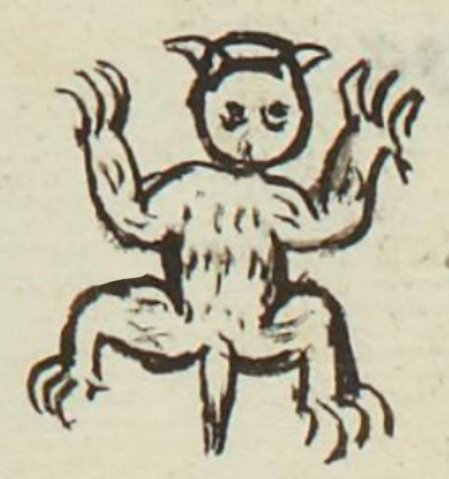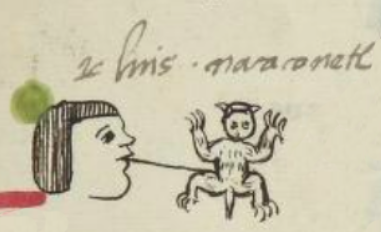Nacaconetl (MH519r)
This black-line drawing of the simplex glyph for the personal name Nacaconetl provides a frontal view of a standing (or semi-squatting) animal or demon with two legs and two (raised) arms, a short tail, two open eyes, and two small horns on its head. Its paws end in long claws. It has a textured body or coat.
Stephanie Wood
There is little in this image to suggest meat or flesh. If nacatl were possessed, it could refer to the whole body, but is is not explicitly possessed here. Further, while the creature may be intended to appear young or a child, this is not obvious, either. The gender of the creature is not indicated, but the name is borne by a man who has been baptized Luis. Spanish conceptualizations of demons seem to have influenced this glyph. Juan José Batalla (2018, 80) has reproduced a number of demons in his study of glyphs that are visual loans from the Western world, and they all have horns (as does this figure here), recalling representations of Satan or the Christian devil. But the personal names linked with these glyphs (e.g., Temamauhti, Tlacatecolotl, Tetzauh, Tetzahuatl, Mohtli) vary considerably, and he does not include Nacaconetl among them. Still, perhaps it could be included. Batalla (2018, 76) mentions cuacuahuitl ("cuerno de animal," animal horns) in his list of visual loans. The shape of this figure is also vaguely reminiscent of the sacred force that was the patron of the sixth month, second day (Trecena 7) in the Codex Borbonicus. [See Elizabeth Hill Boone, Descendants of Aztec Pictography, 2020, 57.] So, it may have a hybrid iconography. Finally, this bird's eye view of an animal or an animal skin is reminiscent of the iconographic example of a butchered jaguar (see below).
Stephanie Wood
luis nacaconetl
Luis Nacaconetl
Stephanie Wood
1560
José Aguayo-Barragán

naca(tl), flesh or meat, https://nahuatl.wired-humanities.org/content/nacatl
cone(tl), child, https://nahuatl.wired-humanities.org/content/conetl
Juan José Batalla Rosado states: “El glifo de luis nacaconetl (MH, s/f: 519r) recoge un ‘monstruo o demonio’ no indígena. El término deriva de nacatl, “carne”, y conetl, “niño, niña” (gdn, 2012; Nahuatl Dictionary, s/f) se traduciría como “niño de carne”,
Niño de Carne
Juan José Batalla Rosado
Matrícula de Huexotzinco, folio 519r,, World Digital Library. https://www.loc.gov/resource/gdcwdl.wdl_15282/?sp=117&st=image
This manuscript is hosted by the Library of Congress and the World Digital Library; used here with the Creative Commons, “Attribution-NonCommercial-ShareAlike 3.0 License” (CC-BY-NC-SAq 3.0).


